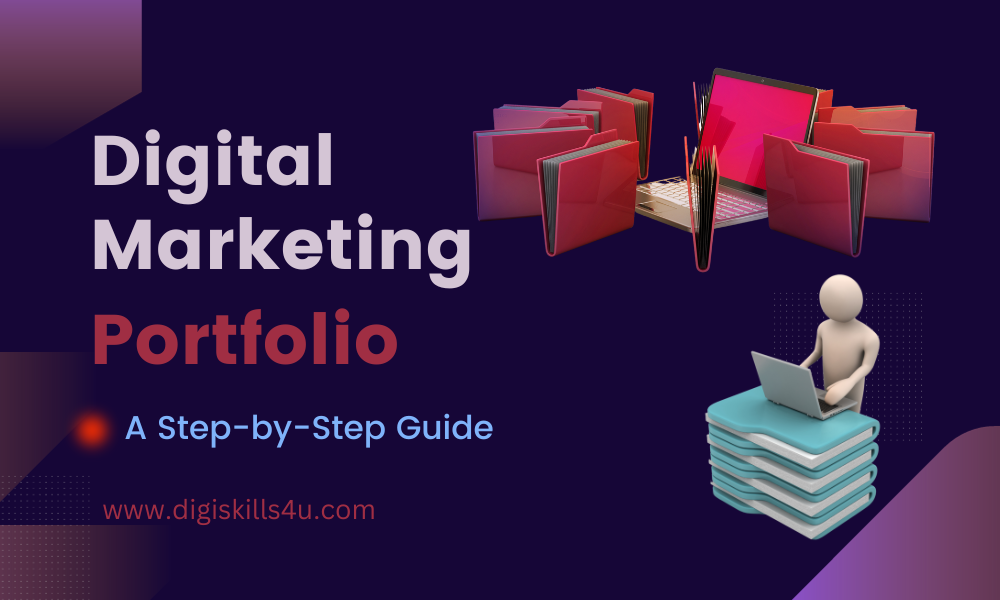Last updated on May 20th, 2024 at 02:35 pm
In the competitive world of digital marketing, having a standout portfolio is crucial for showcasing your skills and attracting potential clients. Whether you’re a seasoned professional or just starting your digital marketing career, creating an impressive portfolio is key to winning new business.
In this guide, we’ll walk you through the process of building a compelling digital marketing portfolio, complete with examples and essential tips.
What is a Digital Marketing Portfolio?
A digital marketing portfolio is a collection of work that highlights your expertise in various digital marketing channels such as search engines, pay-per-click (PPC) ads, and social media. It includes past projects, qualifications, awards, testimonials, and anything else that showcases your abilities as a digital marketer.
Why Do You Need a Digital Marketing Portfolio?
Your portfolio serves as a powerful tool to win over potential clients. When companies are searching for a digital marketer, they often review portfolios to gauge the capabilities of potential partners. A well-curated portfolio provides tangible evidence of your past successes, instilling confidence in clients and increasing the likelihood of securing projects.
Creating a Comprehensive Digital Marketing Portfolio: A Step-by-Step Guide
Embarking on the journey of crafting a compelling digital marketing portfolio requires thoughtful planning and strategic steps. Here’s a step-by-step guide to help you showcase your expertise effectively:
1. Set up a Website for Your Portfolio
Begin by establishing a dedicated website or webpage exclusively for your digital marketing portfolio. If you already have a website, create a new page to showcase your digital marketing prowess. Platforms like WordPress offer customization options and facilitate optimal content creation.
To create a website, you’ll need a hosting provider. Several reputable companies offer hosting services, including Hostinger, Bluehost, and DreamHost. Each provider has its own strengths and pricing plans, so it’s important to compare options before making a decision.
Hostinger is a popular choice known for its affordability and ease of use, making it a great option for beginners.
2. Feature Your Clients’ Work
Secure approval from your clients before including their projects in your portfolio. Request written testimonials to add credibility and offer valuable insights into your collaborative efforts. This not only highlights your work but also builds trust with potential clients.
3. Organize Your Portfolio Stories
Carefully select projects that best exemplify your diverse skill set. Organize your portfolio in a way that tells a compelling story, emphasizing your unique selling points. Create individual case studies for each project to maintain a clean and easily navigable digital marketing portfolio.
4. Utilize Blogging and SEO
Kickstart a digital marketing blog to attract organic traffic. Share industry insights to position yourself as a thought leader. Consider guest blogging on reputable sites to expand your reach and enhance your credibility. Leveraging blogging and SEO practices can significantly boost the visibility of your portfolio.
5. Offer Free or Low-Cost Services
In the early stages of your digital marketing career, consider providing free or low-cost services to build up your digital marketing portfolio. Successful projects, even at an initial lower cost, add tangible value and enhance your credibility as a skilled digital marketer.
6. Showcase Your Projects
Highlight work from your websites and projects to demonstrate your capabilities. Create a social media profile dedicated to showcasing your creativity and engagement skills. Initiating a passion project can further illustrate your marketing abilities and add a personal touch to your portfolio.
7. Network Through Social Media and Email
Actively engage with potential clients on social media by commenting and sharing relevant content. Start a weekly email newsletter to provide valuable marketing tips and updates, establishing a connection with your audience. Networking through these channels helps you build a strong online presence.
8. Seek Referrals from Existing Clients
Encourage referrals from satisfied clients, as positive word-of-mouth serves as robust social proof. A strong referral network can lead to additional clients, enriching your portfolio with diverse projects and endorsements.
By meticulously following these steps, you’ll not only create a standout digital marketing portfolio but also establish a robust online presence, positioning yourself as a go-to professional in the dynamic realm of digital marketing.
What to Include in Your Marketing Portfolio?
When you’re putting together your digital marketing portfolio, make sure to incorporate the following elements to make it stand out:
1. Dedicated Portfolio Page
Design a visually appealing, standalone page on your website dedicated solely to showcasing your digital marketing prowess. This page serves as the gateway for potential clients to explore your skills and achievements.
2. Success Stories
Curate a selection of your best work that effectively demonstrates your diverse skill set. These success stories provide concrete examples of your capabilities and the positive impact you’ve made on past projects.
3. Customer Reviews and Testimonials
Add authenticity to your portfolio by including firsthand reviews and testimonials from satisfied clients. Real feedback builds trust and gives potential clients insights into the positive experiences others have had working with you.
4. Client Name and Website
Provide links back to the websites of the clients you’ve collaborated with. This not only adds credibility but also offers context to the type of projects you’ve been involved in and the industries you’ve served.
5. Call to Action Buttons
Guide visitors through your portfolio by incorporating clear Call to Action (CTA) buttons. Encourage them to take the next step, whether it’s reaching out for more information or inquiring about your services. Facilitate seamless connections for potential clients to reach out to you.
6. Awards and Certifications
Showcase any awards or certifications you’ve earned. This not only highlights your achievements but also reinforces your commitment to excellence in the field of digital marketing.
Examples of Digital Marketing Portfolios
Are you looking for some cool examples of digital marketing portfolios? Check out these two awesome ones:
1. Digital Marketing Agency Portfolio: WebFX
WebFX is a super cool digital marketing agency that helps businesses with SEO, PPC, social media, web design, and email marketing. Their portfolio is like a treasure chest of success stories.
In their portfolio, they have case studies about their work for big clients. Each client’s name has tags next to it, showing what kind of services Web FX did for them – like content marketing, PPC, and local SEO.
They even show off some impressive stats, like how they boosted paid conversions for Maryland Sunrooms by a whopping 670%! Each case study has a button you can click to learn more, and the next page spills all the details about the project and the business.
As you scroll down, you’ll find happy words from clients and a simple form to get in touch with Web FX. They proudly display badges from big names like Google Partner and Inc. 5000, making it clear they’re part of the cool club.
Portfolio of a Digital Marketing Genius: Ryan Stewart
Meet Ryan Stewart, a digital marketing consultant who’s like a superhero for brands wanting to grow big. His website has a fantastic portfolio that’s a bit like a superhero comic but for digital marketing.
In his portfolio, he lists out projects he’s rocked before, and each one has cool stats and buttons to learn more. Clicking those buttons takes you on a journey where you get the scoop on the company, how Ryan cracked their problem, and what magic he did to make it work.
Scrolling down, you’ll catch videos of happy customers talking about how Ryan helped their businesses shine. Plus, there’s a VIP section with badges from big shots like Ahrefs, Forbes, and Inc.
Just like Web FX, Ryan’s portfolio is easy to explore. It’s like a neat storybook where you can jump to his blog, or homepage, or shoot him a message anytime. Super simple, super cool!
By incorporating these elements and drawing inspiration from successful examples, you’ll be well-equipped to create a digital marketing portfolio that not only showcases your expertise but also captivates potential clients.
Final Thoughts
Building a strong digital marketing portfolio is a journey that demands time, consistency, and a strategic approach. It’s not just about showcasing past successes; it’s a roadmap for securing future business opportunities. By following the outlined steps, incorporating essential elements, and consistently delivering excellent service to your clients, you fortify your portfolio over time.
Keep in mind that your portfolio serves as a dynamic showcase of your development and expertise. Regular updates ensure it remains relevant and resonant in the ever-changing digital landscape. The commitment to providing outstanding service to your clients contributes to project success and the testimonials and referrals that enhance your portfolio’s impact.
In the competitive realm of digital marketing, a well-crafted portfolio is your distinguishing factor. It’s more than a collection of work; it’s a persuasive tool communicating your unique value proposition. As you invest time and effort into refining your portfolio, you position yourself not only as a digital marketer but as a standout professional in this dynamic and evolving field.




